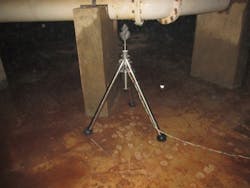Thermally Homogenous but Chemically Stratified Tanks
Pinellas County, Fla., has a distribution system that is typical of many major metropolitan water systems, with over 700,000 customers, 2,000 miles of piping and several large water storage facilities. The Pinellas County Department of Environment and Infrastructure (DEI) has seen a decline in water usage over the last decade, due to both active water conservation programs and downturns in the regional economy. This decrease in water usage, combined with warm southern temperatures, has increased water age and incidences of nitrification in parts of its chloraminated system.
The problem
In 2000, the Pinellas County DEI embarked on a major upgrade in anticipation of its conversion to chloramines as secondary disinfectants and installed passive mixing systems in each of its ground-level water storage tanks. Once the conversion was complete in 2002, the DEI found that nitrification was still an issue in some of its storage tanks. To reduce nitrifying bacteria and biofilm growth, the DEI performed chlorine maintenance (or free chlorine burn) each spring, in which the secondary disinfectant was switched from chloramines to free chlorine for several weeks. The DEI also increased its flushing, averaging roughly 255 million gal of water per year.
In 2009, the Pinellas County DEI experienced its earliest recurrence of nitrification after chlorine maintenance in the beach community at the southern end of the county. Despite the presence of passive mixing systems in its tanks, operators at the DEI were aware that mixing conditions were not optimal. For example, as tanks were drained, operators saw a steady drop of chlorine levels, suggesting that the upper layers of water in the tanks were depleted of disinfectant residual.
“These storage tanks were designed to be full,” said Royce Rarick, senior water plant operator at the Pinellas County DEI. “We would watch the residual drop as the tank was pumped out.”
Temperature measurements at various levels within the tank rarely showed the presence of thermal stratification, but the variations in chlorine levels (and the episodes of nitrification) strongly suggested that the existing mixing systems were unable to maintain homogeneous water chemistry.
The solution
Anticipating further decreases in water demand due to the loss of a secondary water customer, the DEI asked Jones Edmunds & Associates Inc. to study its distribution system and propose infrastructure and operational improvements to reduce the risk of nitrification and the need for large bulk water turnover by flushing. Jones Edmunds recommended the use of active mixers to improve mixing in the storage tanks and contacted Utility Service Group to set up a demonstration test using a PAX Water Mixer. Unlike passive mixing systems, which only introduce momentum into the tank during the fill cycle, PAX Water’s active mixing systems operate 24/7, creating a powerful flow pattern within the tank and ensuring uniform distribution of disinfectant residual.
In order to confirm that active mixing would be sufficient to overcome the chemical stratification inside the tanks, the Pinellas County DEI conducted a performance trial in which temperature and residual would be monitored. Two 5-mg tanks at the North Booster Pump Station were selected. A PAX Water Mixer (PWM400) was installed in one tank, and the other was left as a control. Both tanks were filled and drained only from their outlet sumps, simulating worst-case hydraulic conditions inside the tanks. Temperature probes were installed and grab samples were taken from the bottom, middle and top of each tank every day over a one-week period.
Initially, after the PAX Water Mixer was installed, power was inadvertently set to only 50% of its total power rating.
The results
The temperature data showed only slight differences in thermal stratification between the control tank and the actively mixed tank. The control tank showed slightly more thermal stratification at the top of the tank, but the magnitude was small, averaging only 0.2°C during the study. From the temperature data alone, both tanks would appear to be sufficiently mixed.
It was the chlorine residual data that told the real story. In the control tank, residual chlorine quickly became stratified, with levels 0.5 to 0.9 ppm lower at the top of the tank compared to the bottom. However, in the actively mixed tank, chlorine residual levels were within 0.1 ppm of each other. The data revealed that while thermal conditions remained relatively uniform, significant chemical stratification quickly developed. The active mixer was able to restore homogeneous chlorine distribution throughout the tank.
In a 2013 Florida Water Resources Conference presentation, Jones Edmunds reported its findings: Significant chemical stratification can exist inside water tanks that show little or no thermal stratification. The active mixing system installed in the 5-mg tank was able to eliminate the chemical stratification, even with the worst-case inlet/outlet conditions.
“The most impressive part is that even at 50% of the mixer’s total power rating, it still provided great performance,” said Chris Baggett, senior engineer at Jones Edmunds.
By the end of 2013, the Pinellas County DEI had installed PAX Water Mixers in eight of its tanks. Active mixing was not the only recommendation made by Jones Edmunds and adopted by Pinellas County DEI. Operational levels in some of the water storage tanks were lowered to reduce water age, and pressures were adjusted in some parts of the distribution system to improve flows. Managers also added a second chlorine maintenance event at the end of the warm season, and in one area, a water storage tank was taken offline. As a result, the Pinellas County DEI saw a substantial reduction in its flushing. From 2011 to 2013, monthly flushing rates averaged 35 mg during the first half of the year, whereas in 2014, monthly flushing rates averaged just 17 mg for the same time period—just below Pinellas County’s target of 20 mg per month.
